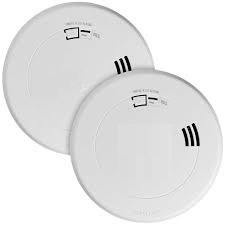hpdsigns.nyc
HPD gas detector requirments per LL157 (pdf file)
- SKU:
- HPD gas detector requirments per LL157
- UPC:
- MPN:
- HPD gas detector requirments per LL157
Description
HPD Natural Gas Detectors REQUIRMENTS PER NYC
Summary of the law:
Local Law 157 requires installation of natural gas alarms in residential properties. In dwellings class A and class B multiple dwellings, one or more natural gas alarms must be installed in each dwelling on or before May 1, 2025. One or more natural gas alarms must be installed in each dwelling where a fuel-gas-burning appliance is installed within a dwelling. The gas alarm must be installed in the same room as the appliance.
What Type of property need to install Gas detector base on LL 157:
Installation required. Natural Gas alarms must be installed in private dwellings, class A multiple dwellings, and class B multiple dwellings as defined in the Housing Maintenance Code.
Private dwellings: One or more natural gas alarms must be installed in each dwelling in Accordance with the law one or more natural gas alarms must be installed in each dwelling where a fuel-gas-burning appliance is installed within a dwelling. The gas alarm must be installed in the same room as the appliance. on or before May 1. 2025.
Class A multiple dwellings: One or more natural Gas alarms must be installed in each dwelling in accordance with law one or more natural gas alarms must be installed in each dwelling where a fuel-gas-burning appliance is installed within a dwelling. on or before May 1. 2025.
Class B multiple dwellings: On or before May 1. 2025. Class B multiple dwellings must be protected by either:
(1) One or more natural gas alarms installed in each dwelling in accordance with this section law one or more natural gas alarms must be installed in each dwelling where a fuel-gas-burning appliance is installed within a dwelling.: or
(2) A line-operated zoned natural gas detecting system, designed in accordance with NFPA 715-2023 by a registered design professional, and installed in all public corridors and public spaces.

Installation of the gas detector and product requirements:
Each single- or multiple-station alarm, as defined in NFPA 715 must meet all of the following requirements:
(1) The alarm must be manufactured in accordance with NFPA 715-2023. Standard for the Installation of Fuel Gases Detection and Warning Equipment:
(2) Installation Requirements: Where a fuel-gas-burning appliance is installed within a dwelling. The gas alarm must be installed in the same room as the appliance. The alarm must be located at least 3 feet, but not more than 10 feet from the appliance, measured horizontally. The gas alarm must be installed on either the ceiling, or a wall. Where installed on a wall, the alarm must be located not more than 12 inches from the ceiling.
Exception: Where the existing space does not allow for installation at least 3 feet from a fuel-gas-burning appliance, or the manufacturer's instructions or NFPA 715-2023 require installation in a different location, alarm installations must be placed in accordance with the manufacturers or the NFPA 715 location requirements.
(3) The alarm must be labeled with the name of the manufacturer:
(4) The alarm must be listed and labeled with either UL 1484 or UL 2075. As applicable: and
(5) The alarm must be kept in good working order.
Who can install these devices:
Natural gas alarms must be installed by a New York City Licensed electrical contractor, who obtains all required permits
Exception: Natural gas alarms that are powered either by battery or by plug-in AC receptacle may be installed by other than a licensed electrical contractor, including but not limited to the building owner, building maintenance personnel, or the dwelling unit occupant.
Three Type of detectors:
Electrically powered fuel Gas warning equipment must be provided with a primary ac power source and a secondary power unless otherwise permitted by the following:
- Direct electric with battery back-up:
Detectors must be permitted to be powered by a monitored dc circuit of a control unit where power for the control unit meets the requirements and the circuit remains operable upon loss of primary ac power.
- Wireless detector battery source with low-power radio wireless system:
A detector and a wireless transmitter that serves only that detector must be permitted to be powered from a monitored battery primary source where part of a listed, monitored, low-power radio wireless system.
- Battery base:
- A detector monitored battery primary power source must be permitted in existing buildings that were constructed before January 1. 2024.

DISCLAIMER these codes may not be the most recent version. The State / federal or other regulation department may have more current or accurate information. We make no warranties or guarantees about the accuracy, completeness, or adequacy of the information contained on this site or the information linked to on the state site. Please check official sources. The requirements for detector are determined by intended use and by applicable regulation. The BUYER is responsible for determining the appropriate detector needed. WE make no warranty or representation of suitability of a detector to any code or for any specific application. IT IS THE CUSTOMER'S RESPONSIBILITY TO ENSURE THAT THE DETECTORS THE CUSTOMER ORDERS ARE IN COMPLIANCE WITH ALL STATE, FEDERAL, LOCAL, AND MUNICIPAL LAWS. Please review terms and conditions prior to purchase. For more information about what is required, see the laws that are referenced and the rules applicable to your city and state. This page is for informational purposes only and is not intended as legal advice, professional advice or a statement of law. You may wish to consult with an attorney.
Related Products

Checklist for Installing Natural Gas Detectors requirments per LL157 (pdf file)
hpdsigns.nyc


Natural Gas Detectors LL157 (PDF)
hpdsigns.nyc


What type of Natural Gas Detectors shell i install per LL157 (word Doc file)
hpdsigns.nyc

Natural Gas Detector Installation LL157 Tenant Acknowledgment ( word Doc )
hpdsigns.nyc






